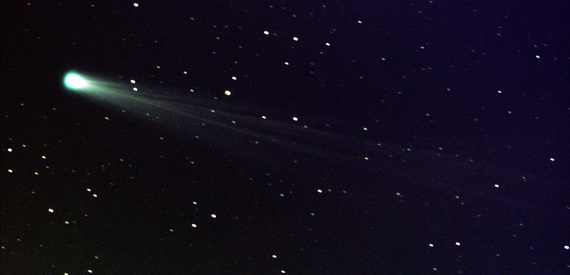Will Comet ISON be the comet of the century? For many amateur astronomers it has already become the comet of the season. For those of us in the northern hemisphere, it has been 16 years since the last great comet visited our skies. When Comet ISON was discovered in September 2012 by two Russian astronomers, Vitaly Nevsky and Artyom Novichonok, part of the International Scientific Optical Network (ISON) searching the skies for just such objects, it was thought that it would become the kind of comet that would send people out into the streets in wonder. So far that hasn't happened, but the next few weeks will tell if ISON will continue to delight those willing to make the trip to dark locations amid cold winter nights or, instead, melt away to nothing.
Comets are balls of primordial ice, rock and dust left over from the formation of our solar system. Scientists love them because they (along with rocky asteroids) give us a look at the original building blocks out of which our planet formed. While a comet spends most of its life far from the Sun's heat, when it falls in toward the inner solar system the Sun's light begins to vaporize its solid surface, creating an enormous cloud of gas and dust that shrouds the nucleus from view. Early observations of ISON last year revealed that it was very bright for its still-extreme distance. This led to speculation that ISON might be huge and therefore might become a dazzling sight in the sky, so bright that it might be visible in daytime.
Comet ISON shows off its tail in this 3-minute exposure taken Nov. 19, 2013. At the time of this image, Comet ISON was some 44 million miles from the sun -- and 80 million miles from Earth -- moving at a speed of 136,700 miles per hour. (Image credit: NASA/MSFC/Aaron Kingery)
These predictions haven't quite panned out. Since this is ISON's first trip close to the Sun, the hypothesis is that it was richly loaded with pristine ices that vaporized quickly and in large quantities as it reached the warmer regions relatively close to the Sun. Though ISON's nucleus is probably no more than 3 or 4 miles in diameter, the cloud of vaporized ice and dust, the coma, is now larger than the continent of Australia.
In the last few weeks, as ISON has gotten even closer to the Sun, the gentle but constant pressure of starlight has caused dust in the coma to stream away from the Sun in an enormous tail. When a comet is at its most impressive, it can become the largest object in the Solar System, with a tail that spans the distance between planets. A comet's tail is like the most beautiful snowflake: No two are ever alike, and each is always a surprise. Wherever a comet is in space, its tail always points away from the Sun.
Thanks to the light emitted from the gasses in the coma and tail, astronomers on Earth are able to determine its composition and thus better understand the building blocks of our planet and the origin of the water and other elements that we find here. Our planet orbits in a continuous shooting gallery of small and not-so-small debris left over from our planet's formation. By looking at our nearby Moon's cratered surface, we know that we've been hit many times in the past. The only reason that we don't see as many craters here on Earth is that we live on a living planet with wind, rain, oceans, and volcanic and tectonic forces that continuously repave our planet's surface.
The dramatic 1994 impact of Comet Shoemaker-Levy 9 into the cloudtops of Jupiter liberated almost 20 million times more energy than the atomic bomb dropped on Hiroshima. Spewing debris over an area larger than the entire Earth, it renewed interest in identifying asteroids and comets that are potential threats. The near miss of a previously unknown meteor that exploded over Chelyabinsk, Russia, in February 2013 (where 7,000 buildings were damaged and 1,500 people were hurt by the shockwave) demonstrated dramatically that impacts on Earth are a matter of when, not if.
Comet ISON is now two days away from a close encounter with the Sun, an encounter that it very well may not survive. On Thursday, Nov. 28, Comet ISON will sweep around the Sun, clearing its roiling surface by as little as 800,000 miles, about equal to the Sun's diameter. After Thanksgiving, one of three fates will have come to pass:
- ISON's icy nucleus wasn't dense enough, and tidal forces (along with blazing-high temperatures) ripped it apart, revealing pristine ices within that were quickly vaporized in these infernal surroundings -- a literal snowball in hell.
If ISON survives, then starting Dec. 1, go outside to a dark location and look toward the east 40 minutes before sunrise. Any tail should point up and away from the eastern horizon. As the week goes on, ISON will rise earlier and earlier and will thus be higher and higher in the predawn sky. By the morning of Dec. 6, ISON will be up for an hour and a half before sunrise, 15 degrees above the eastern sky by the time civil twilight begins half an hour before dawn. Over the month of December, ISON will get higher in the sky as it gets farther from the Sun, but at the expense of its brightness as it heads back into deep space. By Christmas, if it is still visible at all, it will rise near midnight and be high in the sky to the northeast before dawn, giving us a "star" in the east for this holiday season.
The most recent news on Comet ISON can be found here.
